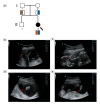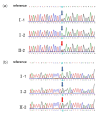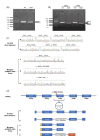Prenatal Detection of Novel Compound Heterozygous Splice Site Variants of the KIAA0825 Gene in a Fetus with Postaxial Polydactyly Type A
- PMID: 35886013
- PMCID: PMC9316509
- DOI: 10.3390/genes13071230
Prenatal Detection of Novel Compound Heterozygous Splice Site Variants of the KIAA0825 Gene in a Fetus with Postaxial Polydactyly Type A
Abstract
Postaxial polydactyly (PAP) is a common abnormality characterized by extra digits on hands and/or feet. To date, sequence variants in seven genes have been identified in non-syndromic PAP. In the present study, a fetus manifesting non-syndromic postaxial polydactyly type A (PAPA) was found by fetal ultrasonography. To better evaluate fetal prognosis, SNP array analysis and trio whole-exome sequencing (trio-WES) were performed to identify the underlying etiology. Although SNP array analysis revealed no abnormality, trio-WES identified compound heterozygous splice site variants in KIAA0825, c.-1-2A>T and c.2247-2A>G in intron 2 and intron 12, respectively. These two splice site variants were absent in control databases and were predicted to influence splicing by in silico analysis. To confirm the potential pathogenicity of the variants, in vitro splicing assays using minigene and RNA from peripheral leukocytes of the heterozygous parents were conducted. Minigene and RT-PCR assays demonstrated that the c.-1-2A>T variant led to the loss of the initiation codon, and the c.2247-2A>G variant mainly resulted in exon 13 skipping. Prenatal WES and subsequent functional studies are important approaches for defining the genetic etiology of fetuses with PAPA and are also essential for accurate genetic counseling and decision making. Taken together, this study expands the spectrum of KIAA0825 variations in PAPA patients and increases the knowledge of the molecular consequences of KIAA0825 splice site variants.
Keywords: KIAA0825; aberrant splicing; functional study; limb anomaly; postaxial polydactyly type A; whole-exome sequencing.
Conflict of interest statement
The authors declare no conflict of interest.
Figures




Similar articles
-
Identification of GLI1 and KIAA0825 Variants in Two Families with Postaxial Polydactyly.Genes (Basel). 2023 Apr 5;14(4):869. doi: 10.3390/genes14040869. Genes (Basel). 2023. PMID: 37107627 Free PMC article.
-
Identification of a novel biallelic missense variant in the KIAA0825 underlies postaxial polydactyly type A.Genomics. 2020 Jul;112(4):2729-2733. doi: 10.1016/j.ygeno.2020.03.006. Epub 2020 Mar 5. Genomics. 2020. PMID: 32147526
-
Variants in KIAA0825 underlie autosomal recessive postaxial polydactyly.Hum Genet. 2019 Jun;138(6):593-600. doi: 10.1007/s00439-019-02000-0. Epub 2019 Apr 13. Hum Genet. 2019. PMID: 30982135 Free PMC article.
-
Genetic overview of postaxial polydactyly: Updated classification.Clin Genet. 2023 Jan;103(1):3-15. doi: 10.1111/cge.14224. Epub 2022 Oct 2. Clin Genet. 2023. PMID: 36071556 Review.
-
A review of polydactyly and its inheritance: Connecting the dots.Medicine (Baltimore). 2022 Dec 16;101(50):e32060. doi: 10.1097/MD.0000000000032060. Medicine (Baltimore). 2022. PMID: 36550802 Free PMC article. Review.
Cited by
-
Identification of GLI1 and KIAA0825 Variants in Two Families with Postaxial Polydactyly.Genes (Basel). 2023 Apr 5;14(4):869. doi: 10.3390/genes14040869. Genes (Basel). 2023. PMID: 37107627 Free PMC article.
-
Case report: splicing effect of a novel heterozygous variant of the NUS1 gene in a child with epilepsy.Front Genet. 2023 Jul 4;14:1224949. doi: 10.3389/fgene.2023.1224949. eCollection 2023. Front Genet. 2023. PMID: 37470039 Free PMC article.
References
-
- Zhou G.X., Dai L., Zhu J., Miao L., Wang Y.P., Liang J., Wu Y.Q. Epidemiological analysis of polydactylies in Chinese perinatals. Sichuan Da Xue Xue Bao Yi Xue Ban. 2004;35:708–710. - PubMed
Publication types
MeSH terms
Substances
Supplementary concepts
LinkOut - more resources
Full Text Sources
Molecular Biology Databases
Research Materials

